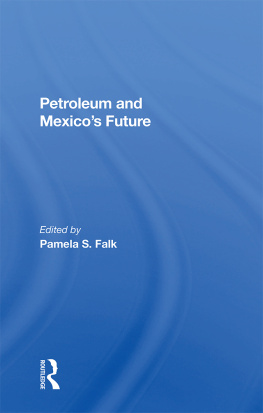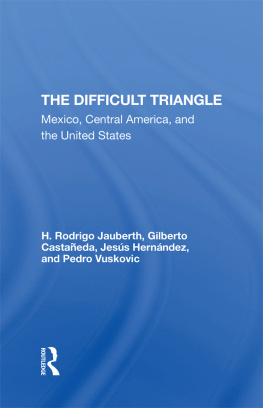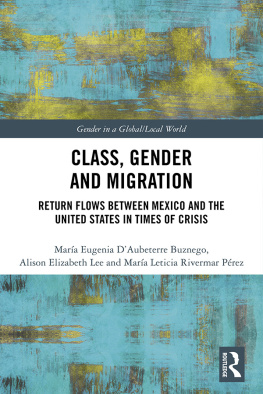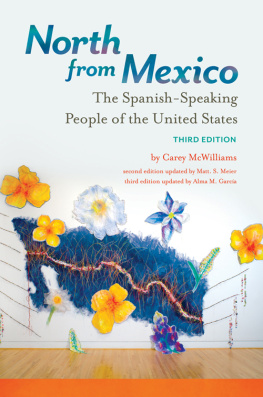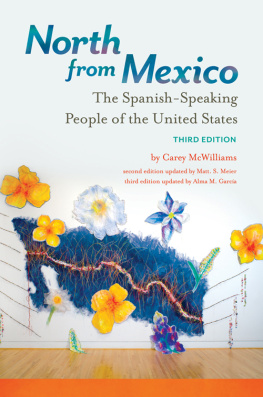United
States
and
Mexico
Ties That Bind, Issues That Divide
Emma Aguila, Alisher R. Akhmedjonov,
Ricardo Basurto-Davila, Krishna B. Kumar,
Sarah Kups, Howard J. Shatz
 |
INVESTMENT IN PEOPLE AND IDEAS |
This monograph results from the RAND Corporations Investment in People and Ideas program. Support for this program is provided, in part, by the generosity of RANDs donors and by the fees earned on client-funded research.
The authors of this monograph are listed in alphabetical order.
Library of Congress Control Number: 2012937838
eISBN: 978-0-8330-5111-0
The RAND Corporation is a nonprofit institution that helps improve policy and decisionmaking through research and analysis. RANDs publications do not necessarily reflect the opinions of its research clients and sponsors.
RAND is a registered trademark.
Copyright 2012 RAND Corporation
Permission is given to duplicate this document for personal use only, as long as it is unaltered and complete. Copies may not be duplicated for commercial purposes. Unauthorized posting of RAND documents to a non-RAND website is prohibited. RAND documents are protected under copyright law. For information on reprint and linking permissions, please visit the RAND permissions page (http://www.rand.org/publications/permissions.html).
Published 2012 by the RAND Corporation
1776 Main Street, P.O. Box 2138, Santa Monica, CA 90407-2138
1200 South Hayes Street, Arlington, VA 22202-5050
4570 Fifth Avenue, Suite 600, Pittsburgh, PA 15213-2665
RAND URL: http://www.rand.org/
To order RAND documents or to obtain additional information, contact
Distribution Services: Telephone: (310) 451-7002;
Fax: (310) 451-6915; Email:
Preface

Despite geographical closeness and many shared economic interests, wariness has characterized relations between the United States and Mexico during the past few decades. Policies designed to curtail the number of Mexican immigrants entering the United States, a 700-mile-long border fence between the two countries, and an increasing illegal drug trade have somewhat eclipsed the North American Free Trade Agreements (NAFTAs) cooperative scope. However, to ensure that the economic and political interaction between the two countries is as mutually beneficial as it is sustainable, it is critical that Mexico and the United States reiterate their commitment to their important relationship. This monograph focuses on how the alliance between the United States and Mexico can be made stronger.
We undertook answering this question by drawing on the perspectives of both countries. This multidisciplinary, binational approach combines economics, demography, and sociology, as well as discussions with U.S. and Mexican policymakers and reviews of published work and of survey results, in order to present a comprehensive analysis of issues that concern each country. The first part of the monograph is a detailed discussion of the issues surrounding migration from Mexico from a U.S. perspective. The second part of the monograph presents the economic and social challenges faced by Mexico. The third part reframes questions of immigration and trade pertinent to both countries by examining the results of opinion polls and trade policy. The final part presents our conclusions and recommendations.
This monograph should be of interest to Mexican and U.S. policymakers, to foreign policy experts, and to organizations and individuals committed to helping to sustain a successful alliance between NAFTA countries. The monograph is a companion to another RAND monograph that examines the security situation in Mexico and assesses its impact on the United States.
This monograph results from the RAND Corporations Investment in People and Ideas program. Support for this program is provided, in part, by the generosity of RANDs donors and by the fees earned on client-funded research.
The authors of this report are listed in alphabetical order. Questions or comments about this report are welcome and should be directed to the project leaders:
Emma Aguila
RAND Corporation
1776 Main Street
Santa Monica, California 90401-3208
310-393-0411 x6682
Krishna B. Kumar
RAND Corporation
1776 Main Street
Santa Monica, California 90401-3208
310-393-0411 x7589
More information about RAND is available at http://www.rand.org.
Figures

Tables

Population and Migrant Share of Top Ten
Migrant-Sending States, 2000 |
Education of Mexican Population and Mexican Migrants
to the United States |
Mexicos Economic Indicators, Before the 19941995
Crisis and 20032008 |
State-Level Disparities in Doing Business in Mexico
in 2008 |
Mexicos Tax Revenue Sources Relative to Those of
Selected Countries in the Organisation for Economic
Co-Operation and Development, 2009 |
Corporate Income Tax Rates in Selected Countries, 2000,
2006, and 2011 (%) |
Federal and Local Government Taxes and Expenditures
in Mexico |
Structure of Revenues and Expenditures, by Level of
Mexican Government, 2000 |
Enrollment and Enrollment Rates in Mexico, by
Education Level, 2000 and 20082009 |
Total Expenditure and Government Expenditure on
Health, Selected Countries, 2009 |
Objectives and Descriptions of Mexicos Social Programs,
2011 |
Summary

The purpose of this study was to assess ways to strengthen the alliance between the United States and Mexico. In this monograph, we provide objective analysis of issues relevant to this unique international relationship. It is our belief that both Mexican and U.S. policymakers would benefit from a detailed discussion of immigration and the social and economic development of Mexico, interrelated issues connecting both countries. Understanding the concerns that drive the debate on immigration in the United States might better enable Mexican policymakers to engage in a constructive dialogue that helps support and reform U.S. immigration policy. In addition, U.S. policymakers might benefit from understanding the social and economic achievements of, as well as challenges faced by, Mexico. Such factors influence many Mexicans decisions to emigrate across the border every year. Although we recognize that there are other issues of mutual interest to both countries, immigration to the United States and the social and economic backdrop of Mexico are topics complex enough to illustrate the progress made by and the challenges that remain for both countries.
The United States and Mexico have always shared a complicated bilateral relationship, which is clearly evidenced by the heavy migration flows and trade agreements of the past 20 years. A major issue of contention between both countries is that of immigration from Mexico to the United States. The September 11 attacks promulgated a tightening of immigration restrictions, which led to the Secure Fence Act of 2006 (Pub. L. 109-367), supporting the construction of a 700-mile-long fence along the MexicoUnited States border. On the other hand, with the elimination of tariffs and other economic trade barriers in the mid-1990s, the North American Free Trade Agreement (NAFTA) has served as a multilateral platform for cooperation between both countries, as well as Canada. In March 2011, U.S. President Barack Obama met with Mexican President Felipe Caldern to discuss working together on issues ranging from drug-related violence, immigration reform, and cross-border trucking to climate change and international politics.



